2018 Hyundai Kona Added to Fast Erupting Small XSUV Segment
- March 22, 2018
- Chevrolet, Ford, Honda, Hyundai, More Categories...
- Posted by George Peterson
- Comments Off on 2018 Hyundai Kona Added to Fast Erupting Small XSUV Segment
The all new 2018 Hyundai Kona small crossover SUV (XSUV) has just been shown to the press in an event held, wait for it, on the Kona Coast of The Big Island of Hawaii. There were 23 or 24 Konas on hand for the journalists to drive around the island. So, this was a pretty big event for Hyundai Motor America (HMA).
In AutoPacific’s 2017 Small XSUV Consultancy, 38 XSUVs with a wheelbase of 110-inches or less are included. There were enough data to do complete analyses on that many individual vehicles. There are an additional seven all new small XSUVs on sale now but too new to have been included in the AutoPacific database. That makes 45 entries in the small XSUV category. Now comes the 2018 Hyundai Kona wading into the fray.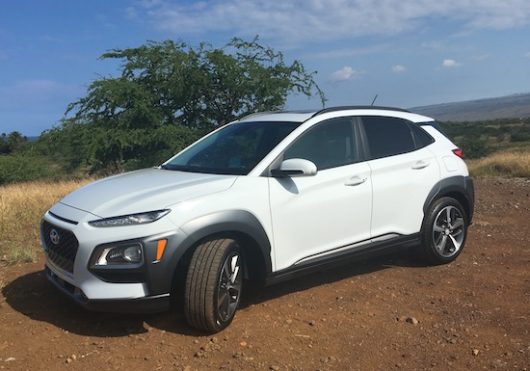
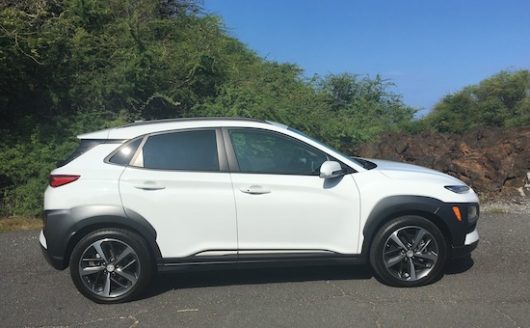
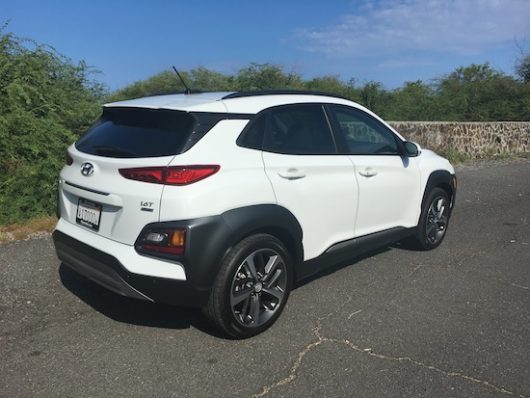
Hyundai Late to the Small XSUV Game Hyundai is a bit late to the game with its B-Segment small XSUV. Hyundai mostly thinks “CARS” and was forced kicking and screaming to develop another small SUV. Before the Kona was developed, Hyundai Motor Corporation (HMC) offered Hyundai Motor America a small XSUV developed mainly for India. Luckily for HMA, their parent company did not push that down their throats and the result is the Kona – a bit late, but a whole lot better. Next year, an even smaller A-segment XSUV will be introduced along with a larger range topping three row seven passenger XSUV (like the old Veracruz). So, it appears HMC got religion and is providing HMA with what it needs to compete.
Trucks to Reign as Cars are De-emphasized As carmakers begin providing what consumers are really asking for – crossover SUVs – the shift from traditional three-box (hood, cabin, trunk) cars will accelerate and the two-box bodystyle will predominate. Truck sales (pickups, SUVs and minivans) outpaced cars in 2010 and now account for about 64% of the market. Crossover SUVs first outsold traditional (body-on-frame) SUVs in 2004 and never looked back. As the small XSUV segment matures, it should command between 17% and 20% of the market of light cars and trucks in the USA.
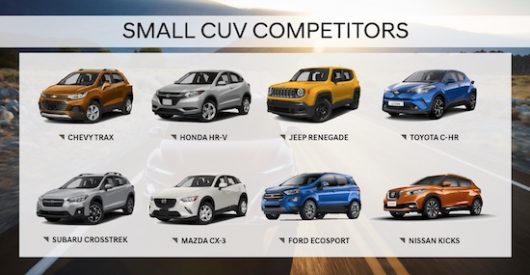 Hugely Competitive Segment Hyundai’s planners identify eight primary competitors for the 2018 Hyundai Kona – Chevy Trax, Honda HR-V, Jeep Renegade, Toyota C-HR, Subaru Crosstrek, Mazda CX-3, Ford EcoSport and Nissan Kicks. With 45-plus entries in its size category sold by popular brands and premium brands alike, Kona goes up against some solid heavyweights.
Hugely Competitive Segment Hyundai’s planners identify eight primary competitors for the 2018 Hyundai Kona – Chevy Trax, Honda HR-V, Jeep Renegade, Toyota C-HR, Subaru Crosstrek, Mazda CX-3, Ford EcoSport and Nissan Kicks. With 45-plus entries in its size category sold by popular brands and premium brands alike, Kona goes up against some solid heavyweights.
Kona Styling The proportions of the 2018 Hyundai Kona are different. It has a long hood with long front overhang and a very short rear overhang. Stylists have achieved a aggressiveness and muscularity in a small package. The front end is has the Hyundai shield grille flanked by large headlights buried in a charcoal surround. LED running lights top the front fascia just at the leading edge of the hood. The bodyside has bold character lines flowing towards the rear. The wheel arches are swathed in charcoal cladding. The cladding may be overdone, but Kona appears to pull it off pretty well. Once you study the Kona for awhile, it grows on you.
Kona Size – Smaller, But Does Not Feel Small Among Kona’s competitive set, it has the shortest overall length (164.0-inches). Its wheelbase (102.4-inches) is pretty much in line with competition. The cockpit feels spacious and its dimensions are in line with its competition. The rear seat is a skosh small with only the Toyota C-HR having less rear seat legroom. While you might think Kona skimped on cargo area it has not. Its 19.2 cubic foot cargo area is mid pack. Only the Honda HR-V and Subaru Crosstrek larger.
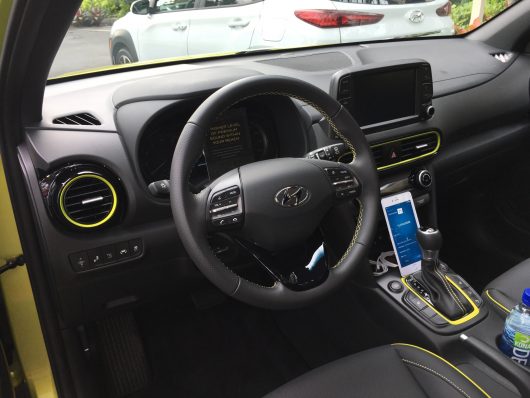 Powertrains – About What You’d Expect in this Class of XSUV There are two engine/transmission combinations. The base engine is a Nu 2.0L Atkinson cycle 4-cylinder with 147-horsepower and 132-lb.ft of torque. The 2.0L is teamed with a 6-speed automatic transmission. The base engine powers the lower two of the four Kona models. The top engine is the Gamma 1.6L GDI 4-cylinder Turbo mated to a 7-speed EcoShift DCT. It has 175-horsepower and 195-lb.ft. of torque. Both powertrains are rated at 30mpg combined city/highway fuel economy. All wheel drive is available on both powertrains and all models.
Powertrains – About What You’d Expect in this Class of XSUV There are two engine/transmission combinations. The base engine is a Nu 2.0L Atkinson cycle 4-cylinder with 147-horsepower and 132-lb.ft of torque. The 2.0L is teamed with a 6-speed automatic transmission. The base engine powers the lower two of the four Kona models. The top engine is the Gamma 1.6L GDI 4-cylinder Turbo mated to a 7-speed EcoShift DCT. It has 175-horsepower and 195-lb.ft. of torque. Both powertrains are rated at 30mpg combined city/highway fuel economy. All wheel drive is available on both powertrains and all models.
Hyundai SmartSense Kona is available with an array of driver assistance technologies in the Hyundai SmartSense Suite. SmartSense includes forward collision-avoidance assist, rear cross-traffic collision warning, lane keeping assist, high beam assist, blind spot warning and driver attention warning. In AutoPacific research, a blind spot warning system is a feature with very high demand. Hyundai has made it standard on the Sonata mid-size car, but in the Kona it is standard one-step up from the base SE model in the SEL model. Still, this is good compared with competitive installations.
Attractive Pricing The base SE model starts at $19,500 (without destination). The highest volume model likely will be the SEL with a starting price of $21,150. It is available with a $1,500 technology package. The next step is the Limited at $24,700. Check all the boxes until there are no more and you come to the Unlimited model at $27,400. The Unlimited is where you get an 8-inch touchscreen with navigation, head-up display and the full Hyundai SmartSense suite of safety features.
No Vehicle is Perfect As vehicles and technology evolve buyers are expecting more. For instance, the 2018 Hyundai Kona has an 8-way power driver seat available, but only manual adjustment (without a height adjustment) is available on the passenger side. Cruise control is standard, but adaptive cruise control that most buyers expect today is not yet available. Hyundai’s planners hint that adaptive cruise is only a short time away.
In Summary The 2018 Hyundai Kona promises to be a very competitive entry in the small XSUV category. A buyer won’t miss much, if anything at all, if they select a Kona. This is a vehicle that Hyundai Motor America has needed and has been waiting for. Now it is up the dealers and marketing/advertising folks to get Kona into the consideration sets of prospective buyers. It should do very well.

